

However, a lot of people neglect the basic facts about them, like “what are archery targets made of”, and “how you should pick one for your own use”. For those who have just got into the hobby, here are the basic facts about archery targets.
Archery Target Basics
Table of Contents
One of the first things you need to understand is that all commercial targets nowadays are divided into four types. Knowing the basic types of archery targets are the most essentials.
Paper Targets
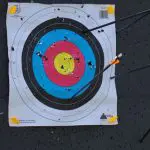 First, there are paper targets. These targets are essentially just sheets of archery paper that have target shapes on them. You place them on the wall or over a solid backing to shoot at. These targets are usually for more than archers. They work for marksmen of all types. Note that these tend to be very fragile and are generally used in conjunction with other targets.
First, there are paper targets. These targets are essentially just sheets of archery paper that have target shapes on them. You place them on the wall or over a solid backing to shoot at. These targets are usually for more than archers. They work for marksmen of all types. Note that these tend to be very fragile and are generally used in conjunction with other targets.
Bag Targets
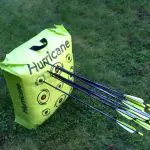 Second, there are bag targets. Bag targets are mainly bags filled with synthetic fiber or other porous materials. When an arrow hits it, it punches through the external covering to hit the internal material. The kinetic force of the arrow is then absorbed by the material so that the arrow won’t penetrate too much. The result is a target that allows people to easily get arrows out.
Second, there are bag targets. Bag targets are mainly bags filled with synthetic fiber or other porous materials. When an arrow hits it, it punches through the external covering to hit the internal material. The kinetic force of the arrow is then absorbed by the material so that the arrow won’t penetrate too much. The result is a target that allows people to easily get arrows out.
Block Targets
Third, there are foam block targets. These targets are literally that: huge blocks of foam. Depending on the manufacturer, they can be solid foam or the softer type. The solid foam type is popular because of the solidity it delivers.
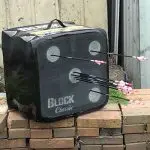
When an arrow hits a foam block target, it generates friction as it passes through the material. This melts it and slows it down until it stops. They are not as effective at stopping arrows as bag targets, but the great thing about them is that there is less damage to the target.
3D Targets
 Finally, there are 3D targets. Made from the same foam core material as block targets, 3D targets add a layer of fun to the target shooting practice. This is done by having them in the shape of various animals.
Finally, there are 3D targets. Made from the same foam core material as block targets, 3D targets add a layer of fun to the target shooting practice. This is done by having them in the shape of various animals.
This can range from simple turkeys or wolves to something fantastic like a dinosaur. These targets work in the same way as foam block targets, so there’s not much difference mechanically.
Archery Target Buying Guide
Now that you know the basic types out there, you’ll want to know how to buy the right set of targets for yourself. Here are the simple criteria that you should look at.
Size
How big your target will depend on a couple of factors. The larger a target, the heavier it is. The size also affects the visibility of the target. If you plan to be shooting from many yards away, you do not want a target that you have to squint at.
Price
Some targets like the paper targets are very cheap and inexpensive. However, some of them can be expensive, like foam core blocks are pricier because of the material they are made of.
Set-up
 Archery targets often need stands to enable you to shoot at them comfortably. Weight also comes into play since you will have to carry the target around. You want a target that you can set-up easily since you want to focus on target shooting.
Archery targets often need stands to enable you to shoot at them comfortably. Weight also comes into play since you will have to carry the target around. You want a target that you can set-up easily since you want to focus on target shooting.Durability
The longevity of the archery target should also be considered. To get good at archery, you are going to need to shoot thousands of arrows at a target. Many bag and foam targets can handle thousands of shots but they are not all made equally. Some targets can handle the damage better than others.
Arrow Removal
Since you will be shooting thousands of times over and over, you’ll want a target that allows for easy arrow removal. Struggling to take out an arrow can result in damaged arrows. Though arrows can be cheap individually, once you shoot them thousands of times, the price piles up. You want a target that allows your arrows to be removed easily so that they can be used again.

These main factors should be at the top of your mind when making your purchase. We created an easy guide for you to remember.

A Bull’s Eye
The right set of archery targets can make target shooting a whole lot easier for you. That’s why you need to know more about them and know how to pick the right one.
Today, there are lots of places where you can try archery, either for leisure or to pursue as a sport. Whatever your reason, one part that you will need to understand is the different types of archery targets.
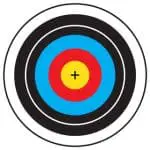 There’s more to archery targets than just a big circle with a dot in the center. Nowadays, different targets are designed to match certain bows, arrows and different tip or broadhead styles.
There’s more to archery targets than just a big circle with a dot in the center. Nowadays, different targets are designed to match certain bows, arrows and different tip or broadhead styles.
There are three main types of archery targets. These are explained below.
Bag Archery Targets
This is the most basic archery target type that every archer or bowhunter has practiced on or even bought for themselves. A bag target is generally filled with synthetic fiber which is responsible for easily stopping your arrow and at the same time still making it possible to easily remove the arrow.
For beginners in basic practice sessions, this archery target works well for repetition. One thing to remember though is that this type of archery target is most often meant for field points.
Keep it out of elements too, as being soaked in the rain can make it deteriorate faster. However, there are now weather-resistant bag targets to address this.
It is suggested to use a bag target in an indoor range where it can be left hanging in place. This is convenient as you do not have to haul it out every single time you practice.
A compound bow setup is also an ideal type for this target. Just remember to use field points and not broadheads because they can remain buried in the target and damage the outer covering that keeps the filling contained within the target.
Foam Layer Block Target
This target is considered the next level after the bag target. A foam layer block target is known to be lightweight and moveable. In addition, it allows for the easy removal of arrows for light bows and is economical as well.
Generally, you have to pinch the arrow between foam layers to make this archery target type work, using friction instead of force to stop its momentum. You can use broadheads on this one, but field points will significantly lengthen the target’s life.
One limitation with this target is that it can be very difficult to remove arrows if they get buried deeply before friction stops them because of heavy draw weight.
Mind your shooting angle too, since you do not want to shoot across or through the layers. To prevent this from happening, turn the block so that the layers are arranged vertically rather than in a horizontal position. This way, the arrow is will slide between layers despite the vertical shot angle.
It is also suggested to use this target for outdoor practice sessions where you can set it up quickly and begin shooting at ground level or from a tree stand. Be careful when using heavy bows as this may make it harder to remove arrows.
3D Practice Targets
Perhaps this is the best archery target type as it prepares you for real-life hunting scenarios. 3D practice targets are replicas of animals, whether alive or extinct, providing a very fun archery experience.
Many of these targets contain different overlay options, such as exposing the vitals on the outside so you have an idea of exactly where your arrow would hit. Others have point values intended for competitive shooting.
One limitation though is the tendency of the foam core to wear out due to repetitive use. But the good thing is that most 3D archery targets contain replaceable midsections, prolonging their life overall. Field points also match this target well. Broadheads may get lost inside the foam core.
Moreover, this target type is ideal for lifelike hunting simulations. When practicing from a tree stand you can set this target up in a realistic setting. Also, it will help you shoot at the shadow of your real target game animal. This target type is light to carry and set up for a few shots down the range or in the woods.
When you are getting into archery, one of the most important pieces of equipment that you can find is a target. This is because you need it to start practicing. To get really good at archery, you need to fire thousands of shots and a target is an ideal equipment for that.
Though it is possible to buy an archery target, you should also learn how to make an archery target of your own. This will save you money in the long run, and make some things easier.
Making Your Own diy Archery Target
Before everything though, you’ll need to know why you need an archery target. Why not just shoot at various items or just a wall? There are several things that make targets important.
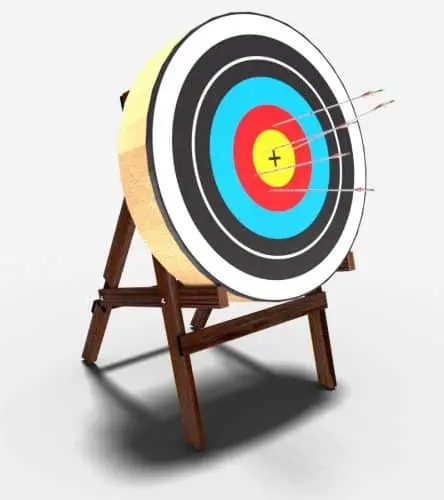 First, archery targets increase safety. Arrows, even field point arrows, are sharp objects traveling at great speeds. If they hit someone, they will get hurt. An archery target provides you with something to shoot at that will soak up the arrows. Instead of arrows just flying about, you will have a target that will take in all the damage instead.
First, archery targets increase safety. Arrows, even field point arrows, are sharp objects traveling at great speeds. If they hit someone, they will get hurt. An archery target provides you with something to shoot at that will soak up the arrows. Instead of arrows just flying about, you will have a target that will take in all the damage instead.
Second, archery targets help save arrows. Though we are in the modern age of mass production, arrows are still very special. Custom-made arrows are often made of materials that can be expensive. Even the ordinary wooden arrows are expensive since they require proper fletching and the like.
Archery targets ensure that they don’t get damaged too much. For example, if you shot at a tree or something similar, the arrow will dig in deep and pulling them out can cause damage to the arrow. Besides that, the tip of the arrow will be damaged if you shoot it at something hard. Most archery targets are made of soft materials that won’t damage metal tips.
Finally, archery targets help you improve your accuracy greatly. When you shoot at an archery target, you often shoot at the specific targets on it. Seeing how well your accuracy has improved is a great step in ensuring that you develop your skill in archery.
Advantages of Home-Made DIY Archery Target
Now that you know what archery targets can do for you, you’ll want to know why you should make one on your own. There are a lot of commercially available archery targets already so you can turn to them, but making your own has several benefits.
- Cheap. One of the biggest reasons why you should make your own targets is that it is cost effective to do so. A lot of the materials that you need for making a target are easily available. Some of them are even recyclable materials.
- Personalized. Commercially available archery targets often have specific sizes and shapes. If they do not have what you want, constructing specific targets that have the size and shape that you want is a good option.
- Disposable. As noted earlier, a lot of these homemade diy archery target is made of recyclable materials. This means you don’t have to sweat about taking care of them. All you need to do is just throw them away and make a new one.
The Materials
There are two parts to look at: the stuffing and the frame. For a simple box target, the stuffing can be any soft material. One of the best choices out there is foam, but you can also get used clothes and rags. All the stuffing needs to be is that it is soft and absorbent. If you have access to hay, that’s a great choice.
The frame is something else. You can find an old cardboard box to do the job. Pick a box that is a decent size. The average commercial target is around 18 inches, so pick a box that is at least that big. You can also choose to make a wooden frame.
Construction
Constructing the target should be quite easy. For a box target, you should just fill up the box with your chosen stuffing. That’s simple to do. When done, just seal it up with tape and draw a target on one side.
For wooden frame targets, you need backing support, usually chicken wire or mesh. When placed, you then put in the stuffing. You then cover it up with some canvas so that the stuffing won’t fall out.
With the targets constructed, you should be ready to go. Note that the box targets should be just thrown away when done. For the wooden frame targets, all you need to do is replace the stuffing and canvas when you think that it has been damaged enough.
Archery Target Height Guide
Just like any other sport, archery has its own set of rules, regulations, standards, and procedures. This ensures fair judging and also means archers know what they are aiming for. One aspect of this is the archery target height. How high or low should a target be? Find out below to improve your archery experience.
Even though archery has already existed for thousands of years ago, there are no universal rules about the correct target placements. There are however professional archery organizations that recommend that each professional archery event makes its own set of guidelines and regulations. Also, it depends on the place where the event is happening—if it is indoors or outdoors.
Casual archery events
There is no existing widely accepted guideline for the target height in casual archery. However, it is recommended that casual archers’ targets are placed at around a 15-degree angle with the center of the target placed at 48 inches off the ground. This makes a height of 48 inches the most commonly used target height in archery.
In reality, it really depends on why you are shooting. If you are at a professional event, 48 inches is most likely the height to be applied. If it is just for practice, you can adjust the height according to your preference.
The correct height for archery targets
A book called The Archer’s Register says that archery targets are generally pitched at an inclination angle to the ground of about 70 degrees. However, there are three other degrees that are also used. Take a look at the table below:
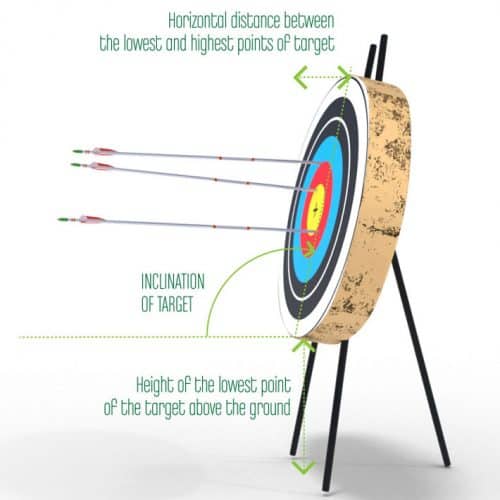
| Inclination of target | The height of the lowest point of the target above the ground | The horizontal distance between the lowest and highest points of the target |
| 60 degrees | 2 ft. and 3 ¼ inches | 2 ft. |
| 65 degrees | 2 ft. and 2 ¼ inches | 1 ft. and 8 ¼ inches |
| 70 degrees | 2 ft. and 1 ½ inches | 1 ft. and 4 ½ inches |
| 75 degrees | 2 inches and ¾ inches | 1 ft. and ½ inches |
Another book called Guide to the Longbow: Tips, Advice, and History for Target Shooting and Hunting state that different manufacturers will recommend various brace heights for bowstrings that usually cover about ½ inch.
For a Fox Archery longbow, the recommended brace height is from 6¾ inches to 7¼ inches. On the other hand, the TimberHawl Falcon longbow’s recommended brace height is from 7 to 7½ inches. The “sweet spot” or height where a bow shoots best and is most efficient falls somewhere between the two measurements.
If you prefer a lower brace height, the arrow will tend to stay on the string longer, which can sometimes amplify any error upon your release. This also allows the arrow to absorb more of the energy of the bow because it stays longer on the string.
Meanwhile, a higher brace height enables the faster release of the arrow, which can help contradict problems if you did a bad release. The arrow tends to absorb a little of the limb’s stored energy, but this small amount is not something to be worried about.
Casual Archery Target Setup
The 48-inch target can be treated as the general height for archery targets today. But again, as mentioned earlier, there are a lot of factors that can affect this rule.

One thing that affects the rule is whether you’re shooting indoors or outdoors. When you’re indoors the height of the target might be lower, while an outdoor venue can welcome either a low or high target.
But are you shooting with kids? If so, they will need a lower target height.
The kind of archery target can also influence how high or low a target should be. Bag and block targets tend to be smaller than 3D targets. However, 3D targets are normally used for practice, so smaller targets will most likely be used.
Building Your Own DIY Archery Target: Best Foam for Archery Targets
Most of the foam archery targets are made of this durable and strong foam. They come in blocks of various colors and weights. However, keep in mind that some foam targets use layered foam as a material, so they’re not self-healing. This is a disadvantage considering that some other archery targets are designed to be self-healing.
Polyethylene
Polyethylene is a closed-cell foam material that is chemically cross-linked so as to resist moisture. The physical makeup of this foam makes it resistant to mildew, bacteria and mold even after a lot of arrow shots. Even when moist, the foam will not break down. It has flexibility as well as the high-shock absorption capacity to handle the impact of powerful arrow shots. This makes polyethylene the best foam for diy archery target.
Targets that contain polyethylene feature a smooth and water-resistant skin on both sides of the foam target face, improving their usability when in outdoors. Moreover, polyethylene targets have plain sheets that are not covered or painted. Therefore, you can apply the design you like, which is something you can easily do given the smooth outer skin.
There is new technology available for foam targets that allow them to self-heal. The most common form of self-healing archery foam targets is a 3D archery target, which looks realistic as it is a replica of an animal that you might hunt. It mimics the shape of the animal so you can aim for something realistic, honing your skills even more. 3D targets have replaceable parts, so you are ensured of their longevity.
Bear Archery Foam Targets
Made of 100 percent self-healing foam, this target is resistant to wear and tear, making it very sturdy. It is also resistant to insects, which means that there is nothing that can burrow inside and destroy its foam.
This target is reversible too, making it versatile. Aside from that, it is waterproof and UV-resistant, which enables it to withstand any kind of weather. If you intend to practice the whole year round, you can do so with this target.
McKenzie TuffBlock Foam Archery Target
Made from polystyrene, this target works well for general target practice, suiting all levels of archers from beginners to experts. It is suggested to use light bows up to 40 pounds only, so as to ensure its longevity. It is super lightweight too, which allows you to carry it anywhere. Make sure to prop this target up against something so it does not fall over.
Rinehart Rhino Brute Target
This target doesn’t bend out of shape despite being shot at repeatedly, and displays great self-healing properties. It works well with broadheads as well as field points and even expendables. Furthermore, it maintains its density well. Like most targets, it is also light and portable, so you can easily carry it wherever you intend to practice archery.
Morrell Yellow Jacket Broadhead Archery Foam Target
Featuring a multi-layered density design, this block-shaped target allows beginners to expert archers to pick their target as there are a lot of variations offered. It comes with an E-Z tote carrying handle so you can effortlessly carry it. In addition, it is weatherproof, so it can withstand cold temperatures, rain and scorching hot days.
Just like the previous product, this target is also designed to work well with broadheads, but it’s not suitable for other arrow types. You can choose either fixed or mechanical broadheads.
These targets still contain polyethylene despite being self-healing. Polyethylene is the best foam for archery targets as it allows products to be sturdy, flexible and versatile, resulting in great customer satisfaction.
DIY archery target
One thing you can do is to make your own DIY archery target. It will just take a couple of hours to make and you will have a target that you can use for a long time. In essence, you just need to stuff a box with some packing materials.
Below are the steps in making a DIY archery target.
Look for a big cardboard box: How to make a DIY archery target
The minimum size should be 30 cm or 12 inches thick so the arrows won’t go through it. If you are using high draw weights or high-speed arrows, make it 146 cm or 18 inches thick.
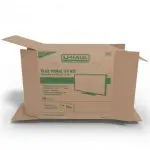 You can decide what measurements should apply on other sides, but normally, 46 cm2 or 18 x 18 inches are the recommended dimensions for beginners and kids. Another thing to remember is to not follow this method unless you are using high-powered compound bows or crossbows.
You can decide what measurements should apply on other sides, but normally, 46 cm2 or 18 x 18 inches are the recommended dimensions for beginners and kids. Another thing to remember is to not follow this method unless you are using high-powered compound bows or crossbows.
Fill with plastic bags or shrink film
 You will need a large amount of shrink film. A lot of stores actually throw this away so you can ask them if you can get their shrink wrap for free. Alternately, stuff the box with plastic bags and fill the box as much as you can.
You will need a large amount of shrink film. A lot of stores actually throw this away so you can ask them if you can get their shrink wrap for free. Alternately, stuff the box with plastic bags and fill the box as much as you can.
Seal the box using tape
Close the box completely using duct tape or packing tape.
Examine the target by testing it
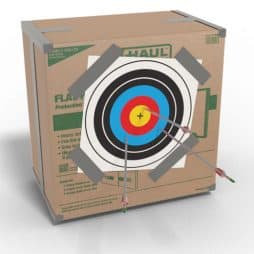 Any open space is a good location since no one is standing nearby. Move closer than your usual distance to be safe. If the arrow shoots right through the box, get a bigger one and ensure that it has a securely packed staffing. Also, arrowheads like field points work well for shooting a target, so use them. Broadhead arrows are not recommended since they can get broken.
Any open space is a good location since no one is standing nearby. Move closer than your usual distance to be safe. If the arrow shoots right through the box, get a bigger one and ensure that it has a securely packed staffing. Also, arrowheads like field points work well for shooting a target, so use them. Broadhead arrows are not recommended since they can get broken.
If you want a more durable target, here are the steps:
Get a wood frame
It is best to choose a lumber frame that is hollow and doesn’t have a back or front side. What you need is a 38 x 286 mm or 2 x 12 inch piece of wood in order for the target to be deep enough to stop arrows. You can decide whatever height and width you like. However, do not go bigger than a shooting zone of 0.9 m2 or 3 ft2 if you want it to be portable.
If you want the target to last a long time even when placed outside the house, protect the target from any kind of intense weather or use kiln dried boards. In addition, the sides can be made of longer boards so they can be extended to the shooting range. As such, you can attach casters or put the target at a higher position for easier portability.
Make a hole for stuffing
Cut a big hole in the board to form the frame’s upper side. You will then fill the box through the hole you have cut.
Bolt the wood together
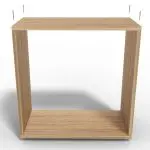 The frame must be locked, and you can do this by using wood screws measuring at least 9 cm or 3½ inches long. Create a more durable frame by threading both frame sides. Use an extra-large washer first to tighten them, then an ordinary washer afterwards. Tighten once more as soon as you finish.
The frame must be locked, and you can do this by using wood screws measuring at least 9 cm or 3½ inches long. Create a more durable frame by threading both frame sides. Use an extra-large washer first to tighten them, then an ordinary washer afterwards. Tighten once more as soon as you finish.
Fasten on poultry netting
Use chicken wire to wrap both frame side openings so the stuffing stays in place. Cover it all over the left and right borders and staple the whole frame with it repeatedly.
Now, there will come a time that the poultry netting will swell due to the force of the arrows. In order to reduce repacking, you can use tie wires (around three to four) on the chicken wire’s interior as support. However, since tie wires are not as durable, others prefer nylon. You can also use a number of thick cardboard layers to strengthen the poultry netting.
Gather stuffing
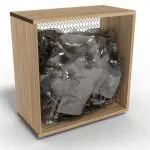
You will need lots of stuffing in order to make an arrow stop and not go through the target. You can get some at stores selling rags or you can ask for any leftover material at retail stores.
Make sure the stuffing is sufficiently compressed
Smaller stuffing scraps can be pushed in from above or through the poultry netting if you see a gap. Use a mallet or any object with the same weight to repeatedly compress as you stuff.
Attach the surface for shooting

Attach the cover underneath planks that can be easily removed and have dimensions of 19 x 84 mm or 1 x 4 inches.
Archery is a very popular sport nowadays, and lots of people use a bow for hunting. If you are still a beginner, shooting targets will definitely help you improve. There are various kinds of targets, and one of the most helpful and advanced is the 3D target. This is a replica of a frequently hunted animal.
You might be wondering how to create your own 3D diy archery target. This can take a lot of time, effort and skill. However, this doesn’t mean it’s not doable. Even if you have not tried it before, you can make a 3D diy archery target!
The materials you will need are:
- Aerosol polyurethane foam
- Newspapers
- Screws
- Drill
- Turkey trap (made of foam) or cardboard (one-dimensional)
- One piece of board (2 x 4 ft., 1 ft. long)
- Two pieces of boards (2 x 4 ft., 3 ft. long)
Here are the steps on how to make 3D diy archery targets
Step 1
Use old newspapers to create several layers to serve as the cover for the flat exterior. Place the turkey trap (made of foam) or cardboard (one-dimensional) on it. Then use a fine spray foam coating to cover one whole side of the decoy, so as to start creating bulk. Wait for at least 24 hours to allow for the foam to dry thoroughly.
Step 2
Turn the turkey trap over. Again, use a fine spray foam layer to coat the other side of the decoy. Wait 24 hours for it to dry fully. Do not rush, and remember to maintain a thin foam layer and avoid thick spray layers since this may ruin the whole thing.
Step 3
Apply an extra foam layer on the trap or decoy, then wait until it is totally dry. Turn it over and put extra foam spray in that area. Again, allow it to dry. Until you are satisfied with how bulky the target already is, repeat this procedure.
Step 4
Lay the two pieces of boards (3 ft. long) parallel to one another in order to build a simple stand. Then place the one-foot-long board on the upper side, making an “H” form. Afterward, fasten the boards and make sure they are properly positioned by using the drill and screws.
Step 5
Again, fasten your 3D decoy using some screws and a drill. Make sure it stands in the middle of the “H” form. This enables your 3D target to stand up straight and be steady once arrows come it’s way.
Here is a video which shows how you can make a archery target at home
Some tips and warnings
You can do some spot repairs using more spray foam after you have shot your 3D target with many holes. Use bigger boards for building the stand if you want a bigger target. Additionally, never shoot your decoy until spray foam is totally dry.
Also, keep in mind that your 3D target must be strong enough to stop arrows. Arrows shouldn’t just pierce through your target. Your 3D target should also not be too hard as this might damage or even break your arrows.
Best 3D Archery Targets
If you then want to know the best 3D archery targets in the market, here are some examples:
Rinehart Woodland Buck Target
This target is made of high-quality materials, making it durable. If it breaks apart though, you can simply replace it. It has the authentic look of a deer that makes it possible for a simulation of shooting while you are in the open fields. Thus, it gives you the best way to practice shooting to know where to hit the deer.
GlenDel Full-Rut Buck 3D Target
This is one of the most expensive targets, and provides several areas you can shoot and practice on. Just like the previous target, it is also replaceable once it breaks due to repeated use. It has the actual weight and size of a real deer, making it one of the biggest targets in the market. It has a four-sided core too, providing more target space than other similar products.
Field Logic Big Buck Shooter 3D Archery Target
This provides a real-life experience given that it looks like the real thing. It has an easy replacement after wear and tear and provides an adequate target space wherever you are standing.
Delta Intruder Buck Target
Known to be one of the toughest targets, this one can stand strong despite lots of wear and tear from arrows because it goes back to normal once the arrows are removed. It comes with padding that can be easily replaced so you can still use it for a long time. Additionally, it has the perfect weight and height just like a real buck, so it doesn’t fall over every time it’s hit.
Archery Targets Guide Conclusion
There is a lot to consider when buying or creating your own diy archery target. You want to make sure that your archery targets meet regulation guidelines and you have durable material to represent best your archery goals. Whether you are a hunter or a competitive archer, there are plenty of options available to buy or create your own archery targets.
Frequently Asked Questions (FAQs)
Ques: What do you use for an archery target?
Ans: By using a foam plank and old clothes, you can make a resilient target to practically anything. You’ll compress rags into the small space instead of cardboard. Old clothes, towels, and sheets are perfect for target stuffing.
Ques: Will a bale of hay stop an arrow?
Ans: If an arrow were shot at a solid surface such as a wall, fence, or anything similar, it would break upon impact. Backstops give you a safe place to shoot if the arrow misses its target. The most common backstop is made of hay bales, which are inexpensive but won’t last as long as a foam alternative.
Ques: Can you shoot arrows at trees?
Ans: There is no problem for archers. Find an old arrow you aren’t worried about destroying or damaging. Ensure the area around and behind the tree is safe.
Want to use this infographic on your site?

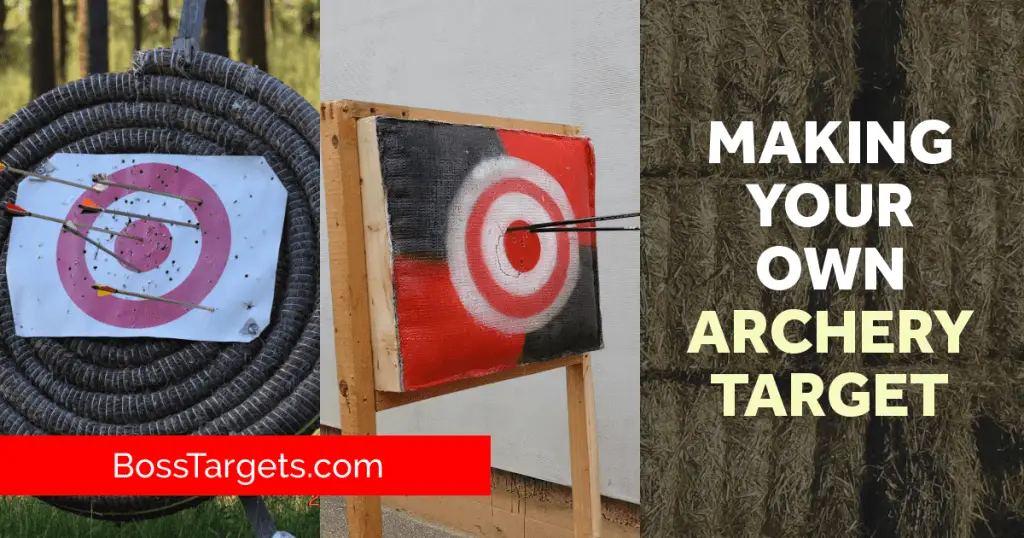
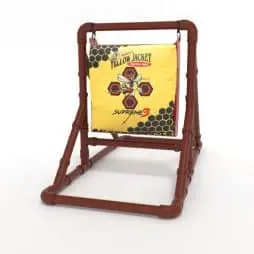 Archery targets often need stands to enable you to shoot at them comfortably. Weight also comes into play since you will have to carry the target around. You want a target that you can set-up easily since you want to focus on target shooting.
Archery targets often need stands to enable you to shoot at them comfortably. Weight also comes into play since you will have to carry the target around. You want a target that you can set-up easily since you want to focus on target shooting.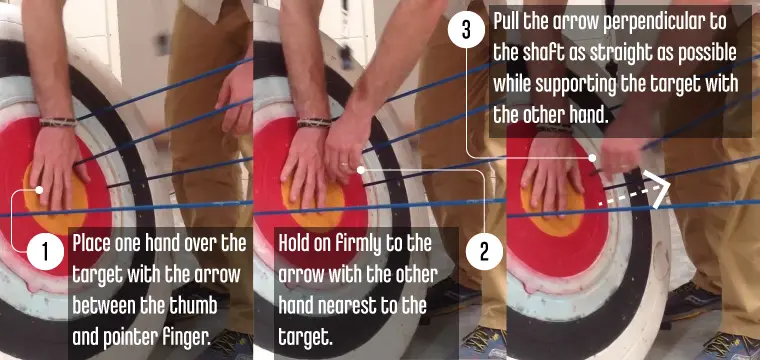
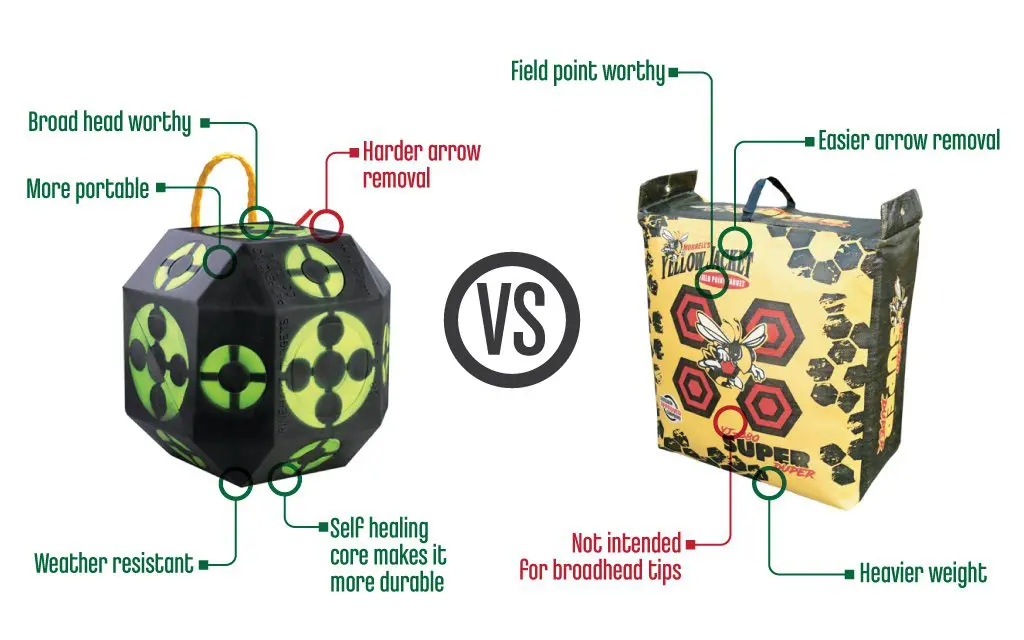
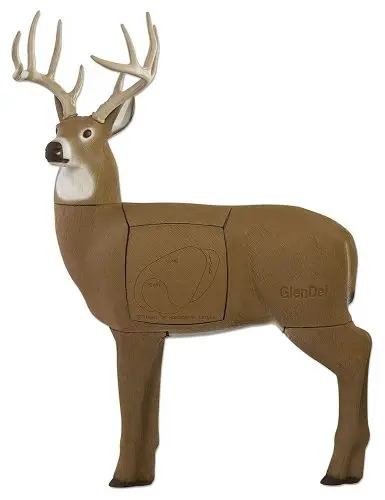
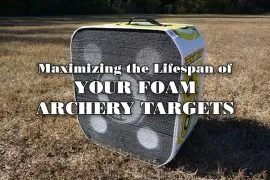

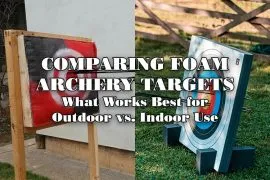
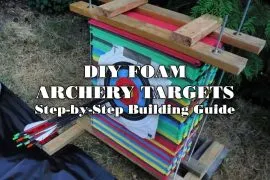
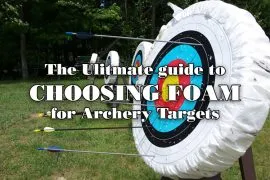

6 Comments
Very cool idea. Another thing that makes a good target is a huge cardboard box filled with newspaper. When I was little my older brother bought an old bow/arrow set and he took a big box, stacked newspapers inside it unlit the box would hardly close, then he flipped the box onto its side so when he shot it, the arrows were going into the bottom of the box because the newspapers were stacked flat and the arrow couldn’t penetrate them. If he had shot the side of the box, the arrow may have been able to sort of wedge itself between the pages and penetrate the target. It worked for us.
Pingback: A Traditional Archer’s Quandary - Boss Targets
Hi, we are in the process of opening an indoor archery range and plan to have approximately 45 feet wide of archery backstop that is approximately 4 feet tall. I’m wondering if you guys have some good recommendations on an up-to-date target that is durable and cost-effective and easy to pull arrows out of? Thanks very much for your help, Chad
Pingback: How Big are Olympic Archery Targets? - Boss Targets
Pingback: What is the Distance in Olympic Archery? - Boss Targets
Pingback: Types of Archery Competitions - Boss Targets